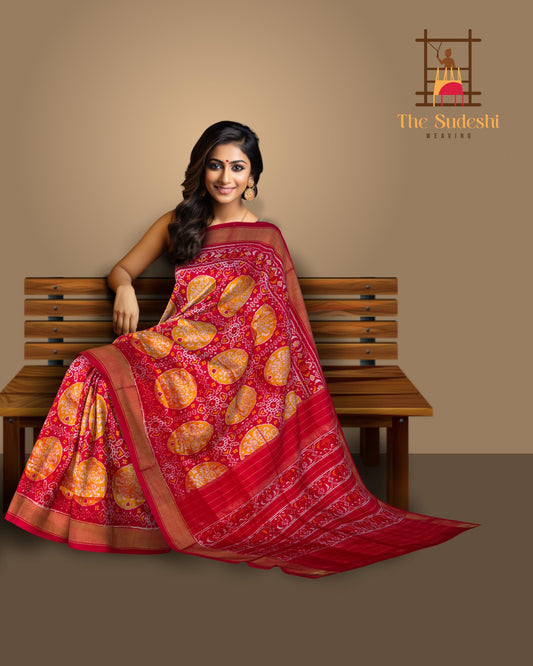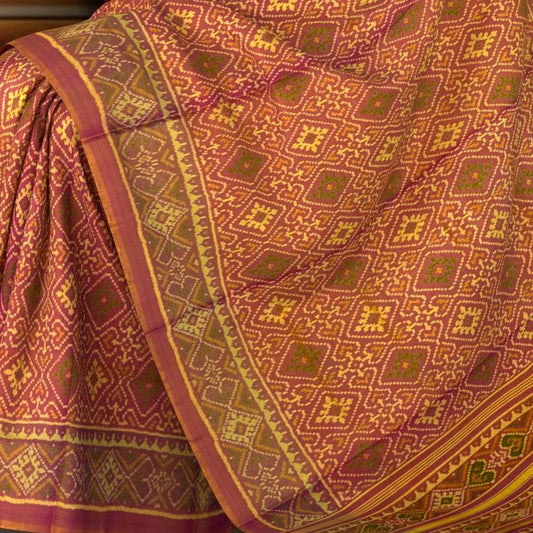The Timeless Elegance of Kanchi & Handloom: Exploring Tradition and Craftsmanship
Kanchipuram, or Kanchi, is a name synonymous with luxurious, high-quality silk sarees that have been cherished across generations. Known for its intricate designs, rich textures, and timeless elegance, Kanchi sarees reflect the legacy of Indian handloom craftsmanship. Handloom weaving, an age-old tradition, is at the heart of this heritage, ensuring that every piece tells a story of skill, creativity, and cultural significance.
In this blog, we’ll explore the world of Kanchi and Handloom, delving into the history, craftsmanship, and the enduring appeal of these beautiful creations. We’ll also discuss how handloom weaving continues to thrive in a modern world that values tradition and sustainability.
1. A Glimpse into the Rich History of Kanchi Sarees
The art of weaving Kanchi sarees dates back over 400 years, making it a symbol of both cultural heritage and artistic excellence. Originating from the temple town of Kanchipuram in Tamil Nadu, these sarees have a spiritual connection to the deities they were often woven for.
The weavers of Kanchi were traditionally from the Devanga and Saligar communities, whose mastery over silk weaving has been passed down for centuries. Kanchi sarees were originally crafted to adorn royalty and the elite, known for their bold, contrasting colors, elaborate zari work, and intricate patterns inspired by nature, mythology, and architecture.
Even today, Kanchi sarees are a quintessential choice for Indian weddings, religious ceremonies, and festive occasions, where their resplendence adds an air of opulence.
2. The Craftsmanship Behind Kanchi Handloom Sarees
At the heart of every Kanchi saree lies the unmatched skill of handloom weavers. Weaving a Kanchi saree is a time-consuming process, requiring precision and dedication. Each saree is crafted on a traditional loom, where the warp (lengthwise threads) and weft (crosswise threads) are woven together by hand.
The process begins with the careful selection of silk threads, often sourced from mulberry silkworms, known for their strength and lustrous finish. These threads are dyed in vibrant colors, and weavers incorporate real gold or silver zari to embellish the sarees with intricate motifs. Common designs include temple borders, floral patterns, and checks, each symbolizing prosperity, nature, or spirituality.
A hallmark of Kanchi handloom sarees is the distinctive contrast between the body and the pallu (the loose end of the saree), a feature that sets them apart from other silk sarees.
3. Why Handloom Sarees Are a Symbol of Sustainability
In an era where fast fashion dominates, handloom weaving stands as a beacon of sustainability. Handloom sarees are woven without the use of electricity, relying solely on the skill of the weaver. This makes them eco-friendly, reducing the carbon footprint and promoting energy conservation.
Additionally, handloom weaving supports the livelihoods of artisans and their families. Each saree purchased directly contributes to the preservation of traditional crafts and provides a source of income to rural communities. The intricate process cannot be replicated by machines, making every handloom saree a unique work of art.
Handloom sarees are also made from natural fibers, such as cotton and silk, which are biodegradable. This positions them as an environmentally responsible choice, appealing to conscious consumers who prioritize sustainable fashion.
4. Modern Adaptations: Kanchi Meets Contemporary Fashion
While Kanchi sarees are deeply rooted in tradition, they have evolved to meet the tastes of modern consumers. Designers are reimagining the classic Kanchi saree with contemporary patterns, lighter fabrics, and more subtle embellishments, making them accessible for everyday wear.
Fusion styles, where Kanchi sarees are paired with modern blouses, jackets, or accessories, are gaining popularity. Celebrities and fashion influencers have embraced the versatility of these sarees, wearing them for both traditional and non-traditional occasions.
Moreover, Kanchi handloom sarees are now available in a wide range of colors, catering to diverse preferences. The intricate craftsmanship remains, but modern elements like geometric designs, pastel shades, and minimalist aesthetics have breathed new life into these timeless pieces.
5. The Global Appeal of Kanchi Handloom Sarees
Beyond the borders of India, Kanchi sarees have captured the attention of the global fashion industry. Their intricate detailing, vibrant colors, and rich cultural significance have made them a favorite among international buyers. Handloom sarees are often showcased in global fashion shows, where they are praised for their elegance and craftsmanship.
Many NRIs (Non-Resident Indians) also hold Kanchi sarees in high regard, as they represent a connection to their cultural roots. For Indian diaspora communities, wearing a Kanchi saree on special occasions is a way to honor traditions and showcase their heritage with pride.
With the rise of e-commerce, handloom sarees are now available to buyers worldwide, enabling them to embrace a piece of Indian craftsmanship from anywhere in the world.
6. Preserving the Art of Handloom Weaving
While Kanchi sarees continue to be celebrated, it is crucial to recognize the challenges faced by handloom weavers. Many artisans struggle to compete with mass-produced, machine-made fabrics that are cheaper and quicker to produce. As a result, the number of traditional weavers has dwindled in recent years.
Efforts are being made to revive and sustain the handloom industry. Government initiatives, designer collaborations, and awareness campaigns aim to promote handloom sarees and provide support to weavers. By purchasing handloom sarees, consumers can help preserve this ancient craft for future generations.
Supporting local artisans and encouraging the younger generation to take up handloom weaving as a profession are essential to keeping the art alive.
7. How to Identify Authentic Kanchi Handloom Sarees
With the growing demand for Kanchi sarees, there has also been an increase in counterfeit products that imitate the craftsmanship of genuine handloom sarees. To ensure you are purchasing an authentic Kanchi saree, here are a few tips:
- Check the Zari: Authentic Kanchi sarees use pure silver or gold zari. If the zari fades over time, it is likely a synthetic imitation.
- Look for a Silk Mark: Genuine Kanchi sarees come with a "Silk Mark" label, certifying that the saree is made from pure silk.
- Examine the Weave: Handloom sarees will have minor irregularities in the weave, which add to their charm and authenticity. Machine-made sarees tend to have a perfect, uniform finish.
- Ask for the Loom Origin: When purchasing from a trusted seller, ask about the loom from which the saree was crafted. Knowing the origin of the saree adds to its authenticity.
Conclusion
Kanchi and handloom sarees represent the intersection of art, culture, and sustainability. With their intricate designs, vibrant colors, and deep-rooted heritage, these sarees stand as a testament to the timeless beauty of Indian craftsmanship. As modern fashion continues to evolve, Kanchi handloom sarees remain a symbol of tradition, luxury, and sustainability.
By embracing handloom, we not only celebrate India’s rich cultural history but also support the artisans who keep this heritage alive. Whether worn for a wedding, festival, or a modern fusion outfit, a Kanchi saree is a treasured piece that carries with it the legacy of an ancient craft.







Leave a comment
Please note, comments need to be approved before they are published.